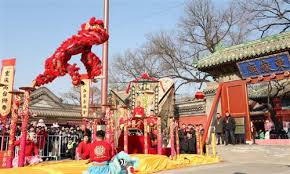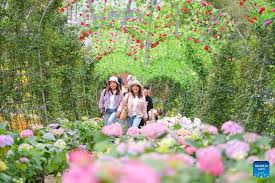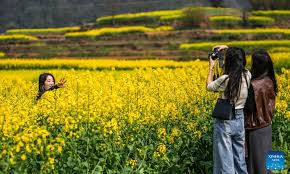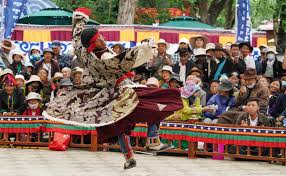Qingming Festival holidays set to boost ‘spring economy’

Henan Daily
Zhengzhou: As China embraces the spring season, the Qingming Festival holidays have sparked a remarkable surge in consumer spending across nation’s cultural and tourism sectors. From traditional flower-viewing excursions to immersive agricultural experiences, the “spring economy” is flourishing nationwide, blending leisure with cultural enrichment.
Scenic destinations have seen heavy foot traffic during the peak blossom period, significantly boosting related industries such as hospitality, catering, and entertainment. Many regions have expanded beyond conventional sightseeing by incorporating agricultural activities, family-friendly programs, and cultural performances, creating diverse springtime consumption opportunities, according to people.cn.
As spring blossoms across the nation, an agricultural tourism base in Northwest China’s Shaanxi is gearing up for its peak season. Blending farming, education, and cultural tourism, the site is set to unveil a sprawling thousand-acre rapeseed flower field in full color—expected to attract even larger crowds. “Since late March, we’ve welcomed hundreds to over a thousand visitors each day, mainly school groups for spring study tours,” Du Yangyang, the activity coordinator of Shaanxi Xinnongxing Modern Agricultural Industrial Park, told the Global Times on Wednesday.

The Qingming Festival holidays in April will kick off the high season, with advance bookings needed to handle the expected crowds, Du added.
The base offers a variety of hands-on activities, from tomato picking in greenhouses to crafting seed art and growing “grass-head dolls.” Located near Xi’an city and popular cultural destination, the Yuanjiacun village, the site exemplifies how rural tourism is fueling the vibrant spring economy, Du noted.
Beyond specific attractions, the spring tourism spending reflects growing consumer enthusiasm for nature-based experiences.
Ticket sales for bamboo forests, grasslands, and scenic trails have more than doubled compared to last year, while theme park bookings have risen by nearly 50 percent year-on-year in recent week, according to tourism platform Fliggy.
China’s railway system is preparing for increased passenger traffic from April 3 to 7, as China Railway Shenyang Group Co reported on Wednesday that the operator anticipates to handle 4.05 million passenger trips during this period, averaging 810,000 trips per day, up 3.8 percent year-on-year. The peak is forecast for April 6, with passenger trips projected to exceed 930,000, according to people.cn.
Domestic car rentals rose 33 percent year-on-year during the holidays, reflecting travelers’ preference for flexible mobility, according to Fliggy.
Travel influencer Wang Yuhao is preparing for a Qingming Festival road trip along Anhui’s scenic “Southern Anhui-Sichuan-Xizang Route,” opting to stay in the less commercialized Zhaji Ancient Village rather than crowded hotspots like Xidi and Hongcun, both are renowned villages in East China’s Anhui Province.
“Local homestay rates have skyrocketed to 900 yuan ($124) per night as demand surges,” he said, noting that how travelers increasingly favor authentic experiences over mainstream attractions.

Wang also highlighted that growing interest in activities like cycling and specialty coffee shops along greenways, reflecting a broader shift toward experiential spring tourism. “These trends are creating new business opportunities, from mobile coffee carts to cycling gear rentals,” Wang told the Global Times.
Regional events are further fueling the spring tourism boom. Xinye county in Central China’s Henan Province has launched its annual flower-viewing event for 2025, featuring vast pear blossom fields, cultural performances like dragon dances and opera shows, and a bustling artisan market, according to media reports.
Urban hubs like Shanghai, Beijing, and Chengdu in Southwest China’s Sichuan Province continue to draw large crowds, while emerging rural hotspots like Shennongjia Forestry District in Central China’s Hubei Province and Zhongwei in Northwest China’s Ningxia Hui Autonomous Region are gaining traction for their pristine landscapes, Fliggy said.
This seasonal surge signals a broader shift toward experiential, culturally immersive travel, confirming the “spring economy” as a lasting trend and a key engine of sustainable tourism growth.
Sales of cycling and camping equipment have seen significant growth, mirroring the rising popularity of outdoor activities, the report said.
“Demand for entry-level bicycles and portable outdoor gear has risen sharply compared to the same period last year,” Chen Kang, director of a sporting goods retailer, told the Global Times on Wednesday. He pointed out that the vast majority of in-store customers are considering purchasing bicycle gears for the upcoming holiday season.
“Looking ahead, China’s consumer market remains resilient, with strong potential and vitality. The fundamental trend of recovery and improvement remains unchanged,” said Li Gang, an official of China’s Ministry of Commerce, during a press conference on March 25.
“Consumers are placing greater value on experiential consumption, making innovative and diverse consumption models key to boosting spending and enhancing quality of life,” Li added.




